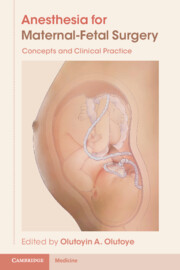Book contents
- Anesthesia for Maternal-Fetal Surgery
- Anesthesia for Maternal-Fetal Surgery
- Copyright page
- Dedication
- Contents
- Contributors
- Abbreviations
- Preface
- Acknowledgments
- Section 1
- Section 2
- Chapter 6 Twin-Twin Transfusion Syndrome
- Chapter 7 Fetal Endoscopic Tracheal Occlusion (FETO)
- Chapter 8 Fetal Cardiac Intervention
- Chapter 9 Antepartum Fetal Monitoring
- Section 3
- Index
- Endmatter
- References
Chapter 6 - Twin-Twin Transfusion Syndrome
from Section 2
Published online by Cambridge University Press: 19 November 2021
- Anesthesia for Maternal-Fetal Surgery
- Anesthesia for Maternal-Fetal Surgery
- Copyright page
- Dedication
- Contents
- Contributors
- Abbreviations
- Preface
- Acknowledgments
- Section 1
- Section 2
- Chapter 6 Twin-Twin Transfusion Syndrome
- Chapter 7 Fetal Endoscopic Tracheal Occlusion (FETO)
- Chapter 8 Fetal Cardiac Intervention
- Chapter 9 Antepartum Fetal Monitoring
- Section 3
- Index
- Endmatter
- References
Summary
Twin pregnancies, especially those in which the twins share one placenta but have separate amnion sacs (referred to monochorionic, diamniotic or Mo-di twins), are at risk for a number of complications. Most notable of these is twin-twin transfusion syndrome. This condition can result in fetal morbidity or intrauterine fetal demise but is also amenable to surgical intervention. Severe discordance in amniotic fluid volumes between each twin is the prenatal finding that highlights this diagnosis. Selective laser photocoagulation has greatly improved the survival of twins with this condition. With a posteriorly located placenta, laser ablation of the abnormal placenta vascular communications can be achieved with local anesthesia and maternal sedation. Anterior placenta location may present a challenge for uterine access that may require modification of the anesthetic technique.
Keywords
- Type
- Chapter
- Information
- Anesthesia for Maternal-Fetal SurgeryConcepts and Clinical Practice, pp. 83 - 94Publisher: Cambridge University PressPrint publication year: 2021



